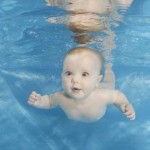Swimming and learning languages are apparently two things which have little in common with each other
 However when I was pregnant with my first child, I was already convinced, my son would be both: a good swimmer and bilingual. Visions of New York Mums suing nurseries comes to mind to many when a mother decides on their child’s future in this way because, horror of horrors, the children spend all day “playing”. I don’t expect my son to be a genius. I just want him to be happy and these two things have a lot to do with achieving this plan. But what do they have in common? And why choose these two things in particular? Swimming and languages are healthy and improve your quality of life.
However when I was pregnant with my first child, I was already convinced, my son would be both: a good swimmer and bilingual. Visions of New York Mums suing nurseries comes to mind to many when a mother decides on their child’s future in this way because, horror of horrors, the children spend all day “playing”. I don’t expect my son to be a genius. I just want him to be happy and these two things have a lot to do with achieving this plan. But what do they have in common? And why choose these two things in particular? Swimming and languages are healthy and improve your quality of life.
“Healthy mind, healthy body” This is obvious in the case of swimming, but what has it got to do with bilingualism? It’s been proved – bilingualism maintains a healthy mind.
Scientific studies show that bilingualism slows down Alzheimer’s by up to 4 years. The bilingual mind has to constantly differentiate between different languages which acts as a sort of mental gym. On the other hand the health benefits from swimming are obvious, and although none of us like to discuss certain aspects statistics show that accidents in swimming pools are one of the main mortality causes amongst children in Spain. The good news is that it’s easy to teach children to swim from birth and therefore keep them healthy and safe.
When to start – Now
You can take your baby swimming from 6 weeks old. And it’s important to do it from as early as this. Children under 6 months have a reflex which allows them to maintain their breath under water in a spontaneous fashion, something which is lost later on. It’s important to take advantage of this so that the child learns to swim under water and doesn’t fear the water. Little by little, with dedication and specific exercises they will also learn to float on their backs. The next step is to show them how to do the doggy paddle from the centre to the edge of the pool. All this will keep your baby safe.
With respect to languages, the ideal is to learn from birth, or at least before 10 months old. This is because there is a window of opportunity with children between the ages of 10 and 12 months where children absorb phonemes particularly well. Children learn this with ease up until around 3 years old, this helps them speak a language without an accent and effortlessly. For all these reasons, getting an early start is important.
Constancy is key
In the case of languages, to become truly bilingual, it’s recommended that the child is exposed to the second language at least 20% of his waking hours. To learn to swim there is no minimum requirement, but it’s best to take them to swim several times a week for short sessions rather than for one long session once a week. Also, babies and toddlers don’t tolerate low water temperatures for more than 30/45 minutes. In any case, practice makes perfect.
Family involvement will help them to improve
Nature or nurture? Are we born the way we are or do we become what we are? Amy Chua, the most famous and controversial mother of the moment, forced her children to practice classical music for several hours a day under her supervision without a break and until they got it right. She did the same with mathematics, science and other academic subjects until her daughters got into Harvard (and of course no nonsense drama classes or other “wasteful” activities). Without going to the same extremes as Chua it’s true that children enjoy activities which through practicing from an early age they master. And which in turn bring them recognition. To achieve this is part of our job as parents and carers.
To enjoy the water and overcome fears is easy when surrounded by family and friends. If you visit a pool on a regular basis the children will learn to relax and will associate it as something enjoyable with positive stimulation. Besides being healthy and enabling motor development swimming has psychological benefits too. It develops family bonds and the children’s self-confidence. Children feel more independent as they are able to move freely without even being able to walk yet.
As I was saying, to be bilingual it’s essential to start early and to practice at least two hours a day with everyone involved whether the learning is easy or difficult. This last point is key, as some bilingual children get stuck and frustrated as no one seems to understand them properly. When faced with this situation the solution is clear: it’s necessary to reinforce reading and games which involve interaction. This can only be achieved with the collaboration of all.
Conclusion:
If you want your children to swim like fish in the sea – literally and metaphorically speaking with languages – we recommend some simple steps. Start early, dedicate the necessary time, be constant and give them plenty of support.
Learning in a simple and natural way from birth is a gift which will accompany your children throughout life. And it will keep them healthy and safe too.